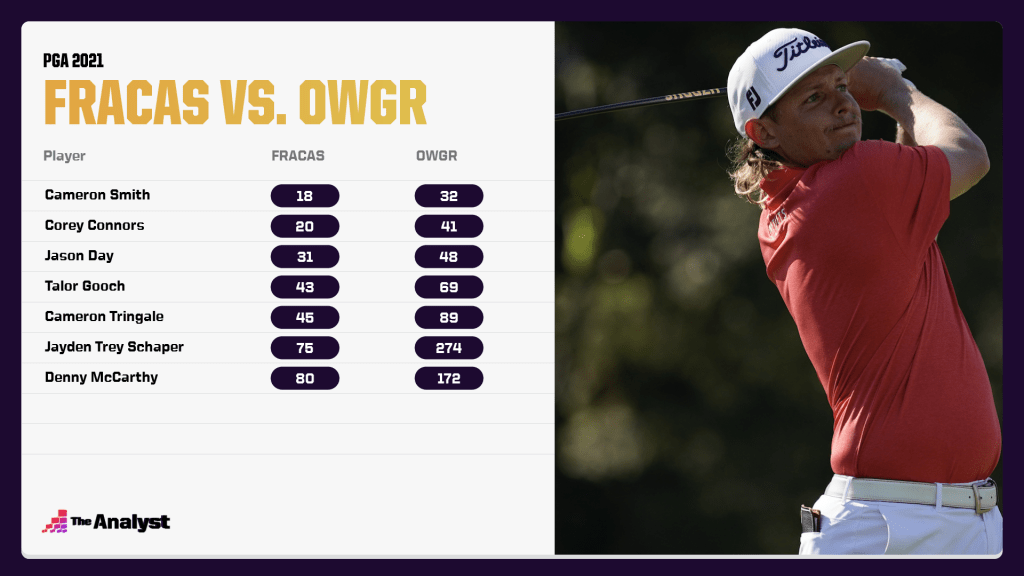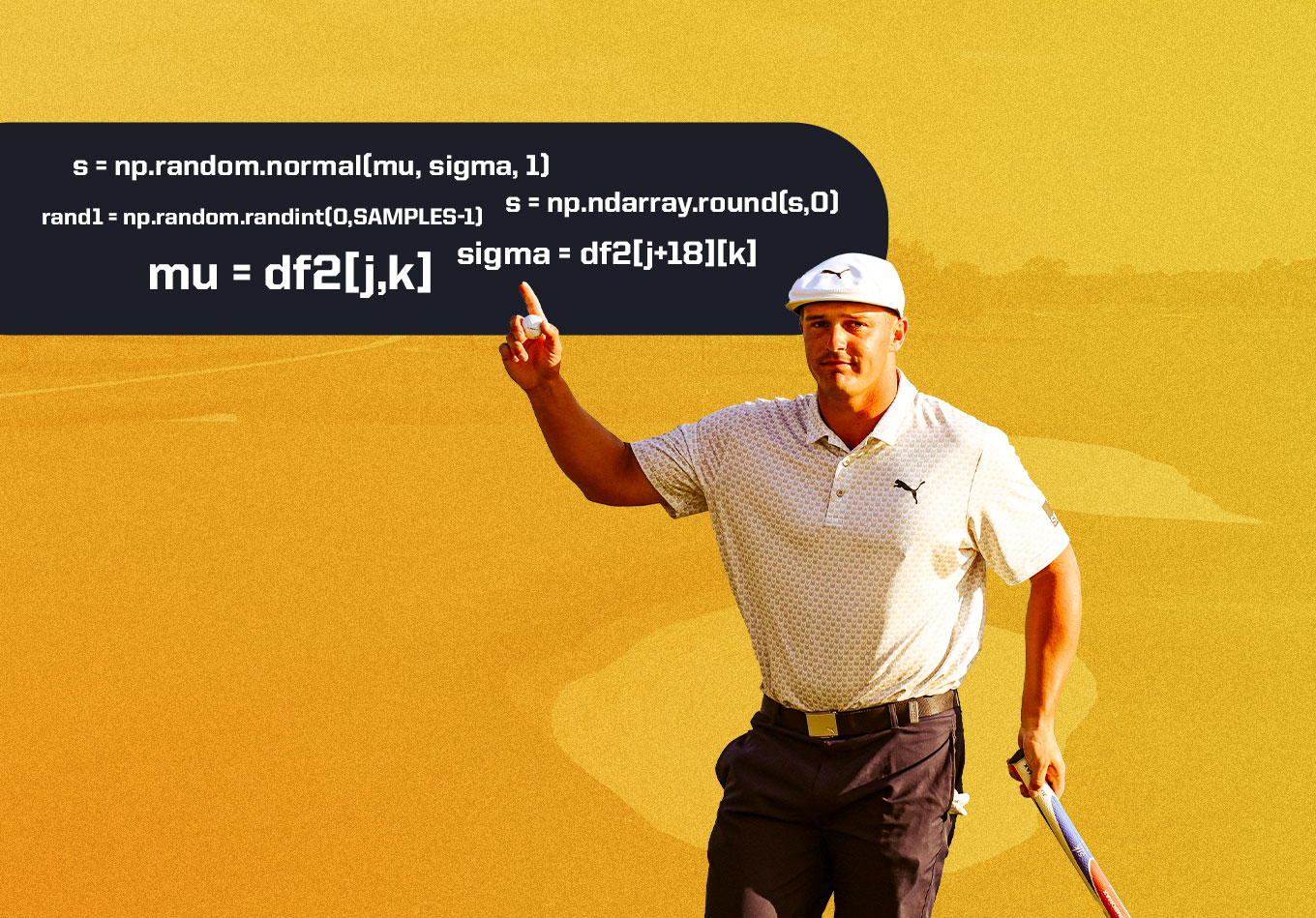Our AI team has been experimenting with golf data for a while now, and we’re ready to put it to work on The Analyst. Here, we explore the leading ranking systems in golf today, explain FRACAS, then put it to work to identify some of the underrated golfers in the game today.
Ranking players is difficult in golf.
In other sports, you’ve generally got a set number of games against a common group of teams within a contained league. In golf, it’s abundantly international, there are tours of varying quality all over the globe, and players are independent contractors who are either invited to tournaments or qualify via performance in other tournaments.
Additionally, tournaments are played at a wide variety of courses and strength of fields. With the variance in individual skill sets of golfers, players can be terrible at one course and a consistent contender at another, and it can be because the golfer likes the course or because the tournament is played with a weaker field.
There’s also the issue of small sample size. Golfers participate in around 20 sanctioned tournaments a year, which is hardly enough of a sample size to draw conclusions from, especially considering the variances we’ve already discussed. So how do we take thousands of golfers across the world playing on all levels of tours and course designs and get them all into one ranking system?
Perhaps there’s another question to back up and answer first: Why do we even want to do this? Well, predictions are the biggest reason. With the predictive culture in golf now evolving just as it has in other sports, we want the ability to look at a tournament and predict as accurately as possible what will happen. As to how, we’ll look at some existing methods first before presenting our own solution. We’re calling it Field Rating and Course-Adjusted Strokes Gained. Or, just FRACAS. The acronym isn’t quite as precise as the model.
Rankings Systems that Exist Today
The Official World Golf Rankings (OWGR) is the most widely available resource for player rankings. The OWGR assigns a strength of field value to each tournament based on who is playing, and then assign world ranking points based on a player’s finish in that tournament. For example, the 2021 Players Championship had a strength of field of 840 and the winner was awarded 80 points. Players accumulate points, and more recent tournaments hold a higher weight than past tournaments.
What’s important to keep in mind with the OWGR is that the rankings are used to qualify players for different tournaments. If a player is inside the top 50, he’s automatically qualified for any upcoming major tournament. The OWGR does an excellent job of explaining how each player has earned their place in upcoming tournaments and loosely explains player skill, but it has no interest in predicting future performance. Since we’re most concerned with prediction, we can borrow the good pieces of how the OWGR is compiled without the downside of concerning ourselves with providing qualification criteria.
Each tour has its own mini OWGR. On the PGA Tour, they’re called FedEx Cup Points. On the European Tour, they’re called Race to Dubai Points. Much like the OWGR, these are cumulative point systems that reward finishing positions based on a predetermined allocation of points. Again, not super concerned with prediction.
And that’s about it. There are a number of golf stat companies that have proprietary rankings, but in terms of widespread use, it’s the OWGR and individual tour points. Not much to work with.
Our Model
Introducing FRACAS (Field Rating and Course-Adjusted Strokes Gained), the model we’ll us for The Analyst’s golf rankings and tournament predictions. First and foremost, we’ll look at everything as strokes gained. Why? Because different courses have different expectancies of score, so using something like cumulative strokes under par or over par can inappropriately weight good performances at courses where scores are super low. A golfer shooting minus-14 and out-scoring the field by three strokes should be the same as a golfer shooting plus-2 but out-scoring the field by three strokes. We’ll compare all golfer performances to how the average golfer fared in that tournament. We’ll get back to this, but for now let’s discuss how we solve the player rating problems we discussed above.
For a quick refresher, these are:
- Strength of Field
- Variety of Courses Played
- Sample Size
Strength of field is an area we feel like the OWGR gets right. In fact, we use the strength of field numbers from the OWGR to adjust our strokes gained. Using some modeling, we can adjust a player’s total strokes gained in a field by the strength of the field. This allows us to standardize all tournaments to one single standard.
Let’s look at two top golfers for an example. Patrick Cantlay plays in tournaments where the average strength of field is 556, and Will Zalatoris plays in tournaments where the average strength of field is 232. When looking at their performances in those tournaments, that difference alone is worth about 0.5 strokes. That may not seem like a lot, but half a stroke is what separates our No. 17 golfer in the world from our No. 38 golfer.
Variety of course played is something we can also normalize by looking at strokes gained on individual holes, rather than per round or per tournament. We can categorize holes based on par and yardage, eventually bucketing holes into one of five categories:
- Short par 3s: par 3s under 195.5 yards
- Long par 3s: par 3s over 195.5 yards
- Short par 4s: par 4s under 449.5 yards
- Long par 4s: par 4s over 449.5 yards
- Par 5s
We’ll note that for par 3s, anything between 178.5 yards and 212.5 yards is considered both a short par 3 and a long par 3, weighted proportionally towards one or the other depending on the length. We use similar logic for par 4s. This allows us to stylize golfers based on their strengths. In the below example, you can see how a cluster of golfers ranked similarly overall can have big differences in how they fare on individual holes. Since we’re using strokes gained, larger numbers are better in this case.
| Player | Short 3s | Long 3s | Short 4s | Long 4s | 5s |
|---|---|---|---|---|---|
| Thomas Detry | .018 | .023 | .053 | -.005 | .059 |
| Brendan Steele | .037 | .062 | .008 | .09 | -.015 |
| Keegan Bradley | .019 | .072 | .025 | -.016 | .094 |
| Ryan Moore | .031 | .038 | .083 | .012 | -.041 |
| Adam Long | -.048 | -.005 | .042 | .066 | .036 |
| Harold Varner III | .013 | .069 | .032 | .015 | .031 |
To clarify what this chart means, we’ll look at Ryan Moore. If we look at short par 4s, Moore gains 0.083 strokes per hole. But on par 5s, he actually loses strokes against the field.
When standardizing to one world average, we like to use the average course composition of strong tournaments. At present, that’s 2.04 short par 3s, 2.01 long par 3s, 6.16 short par 4s, 4.57 long par 4s, and 3.21 par 5s. While FRACAS will change depending on which course is being played, this is the course composition we’ll use for our overall rankings.
Looking at holes rather than rounds or tournaments also greatly increases our sample size. If we look at how each player performs on each hole relative to field average, we’re increasing our sample size 18-fold. This allows us to drill down further into both how a player scores on each type of hole and the variance of how they score.
Recency adjustments is another area we need to explore. The OWGR uses it, but we’ve found that it’s very aggressive. Using our database, looking at a golfer’s strokes gained per round in a tournament predicts their strokes gained per round in their next tournament within an average of 1.81 strokes. Meaning if we use only that previous tournament’s per-round average as an input, and a golfer gained 1.2 strokes in that tournament, we would expect his next tournament to be, on average, between 0.6 strokes lost and 3.0 strokes gained per round. That’s not very much.
If we look at a golfer’s 26th most recent tournament, it predicts their next tournament performance within an average of 2.03 strokes. Worse, but not that much worse. We use a decay formula to weight recency, and using some experimentation, we’ve determined that our decay factor is 0.9385. That means each tournament is weighted at 0.9385 of the next tournament. It’s a mild decay, and we find that it properly weights recent results while also maintaining an element of long-term baseline.
So that’s the FRACAS model. The next step is to put it to use, which we’ll do each week on The Analyst for an overall rankings system and pre-tournament analyses.
We’ll do that below by applying it to the tours we collect hole-by-hole data for and using it to identify some of the world’s underrated golfers. You’ll recognize some of those names. Others, you may be googling.
So What Does the Model Say?
In review, using adjustments for hole types and strength of field, we can rank golfers for any course setup based on historical and recent performance. But what about a generic ranking, how would we do that? Using an average world tournament where strength of field is greater than 100, we can establish what an “average” tournament would consist of. As stated above, at present that is 2.04 short par 3s, 2.01 long par 3s, 6.16 short par 4s, 4.57 long par 4s, and 3.21 par 5s.
As a reminder, we collect data for the PGA Tour, Korn Ferry Tour, DP World Tour, Challenge Tour, Japan Golf Tour, Sunshine Tour, Asian Tour, PGA Tour Australasia, PGA Tour Latinoamerica and Forme Tour.
Using this model, the top five golfers are Jon Rahm, Justin Thomas, Xander Schauffele, Bryson DeChambeau, and Dustin Johnson. That checks out. On individual hole types, the leaders are:

Stewart Cink?! Here is where the model breaking out performance into hole types really shines. Cink is our 103rd player in the world, but his short iron game remains impeccable in his older age. That and a solid putter means lots of birdies on short par 3s. Looking at longer par 3s, it’s logical that DeChambeau would have success. His scientific approach to gaining club speed means he’s hitting 8-iron when others are hitting 4-iron. That’s a lot more loft and control. Dustin Johnson leading in long par 4s also makes a lot of sense. He’s long off the tee and one of the best iron players in the game, a perfect combination for long and difficult par 4s.
While the top five is always interesting, what happens when we dig a little deeper down? Which golfers does the data show to be on the rise, or perhaps underrated? We’ll use the Official World Golf Rankings to compare to our player rankings to find golfers who the model thinks are names you may need to familiarize yourself with.

If you follow golf, you’re probably aware of 27-year-old Aussie Cameron Smith for his unique mullet and mustache combination, but we also think he’s a top-20 player in the world. He has the right game to compete in the top tournaments in the world. In his last 10 tournaments, he has top-20 finishes in The CJ Cup, The ZOZO Championship, Masters Tournament, The Genesis Invitational, WGC-Workday, and The Players, all of which had strength of fields eclipsing 600. Oddly, his worst performances come in weaker fields.
If we look at his strengths and weaknesses, this does start to make sense. He’s strongest on par 5s, short par 3s and long par4s, which are typical hole types of tough tournaments, which is typically where the best players come to play. For Smith, he may never be a prolific winner, but we wouldn’t be surprised if he finished his career with half of his wins coming in majors or other big tournaments.
Corey Conners got his tour card by winning the Houston Open as a Monday Qualifier and has been slowly climbing the rankings ever since. The Canadian is a premier ball-striker, and if he can ever figure it out with his putter, he can compete at the highest level. He scores his best on par 5s and short par 4s, where his ball-striking can put him close enough to the hole to make birdie or eagle without having to rely on the putter.
Easily the most well-known of the names listed so far, former World No. 1 Jason Day has been derailed by injuries and hasn’t won since 2018. And 48th in the world is just too low for our model’s liking. Day’s issue has, remarkably, been easy holes. His worst scoring comes on short par 3s and short par 4s, while he plays the longer versions considerably better than tour average.
We could essentially copy and paste what we said about Cam Smith into Talor Gooch’s section, sans mullett. Like Smith, Gooch has the game to excel when the course is tough and the field is strong, but he hasn’t quite reached that upper echelon of players where he can compete to win one of those tournaments. Twenty-nine years old is still young in golf, and Gooch’s skillset should continue to develop to a point where he breaks through big time in a strong field.
Once a promising young star out of Georgia Tech, 33-year-old Cameron Tringale has yet to find his first PGA win. His darkest time was in 2018 when he missed 19 cuts in 27 events, but since then he’s made 40 out of 50 cuts. Though still only finishing in the top 10 five times in that span, we think better performances are on the horizon. The trouble will be finding a course that suits him. He’s good at all hole types, but not great at any of them, though par 5s are where he’s best so perhaps a weaker-field par 72 is where the win will come.
Who? Get to know this South African. Jayden Trey Schaper just turned 20, just turned professional, and already has a half dozen top 10s in just 20 tournaments. His career highlight so far was a T2 at the Alfred Dunhill Championship in November of 2020 where he made it to the final pairing on Sunday, eventually losing to countryman Christiaan Bezuidenhout. As the sample size gets bigger, we keep waiting for Schaper to drop in the rankings, but he just keeps playing well. His par 5 performance is currently ranked top 20 in the world by the model, though his long par 3 and long par 4 performance plays below tour average. Unsurprising for one so young, but the sky is the limit for the young South African.
Arguably the best putter on tour, 28-year-old Denny McCarthy has shown some recent improvement with his irons. If he can get them even a little above tour average, his putting should carry him to a win. It’s more likely his win will come on one of the shorter courses on tour as he doesn’t hit it very far, but he’s ranked around players who have found wins, like Si Woo Kim and Joel Dahmen, so a win in the next year or two is not out of the question.
Design by Matt Sisneros.
